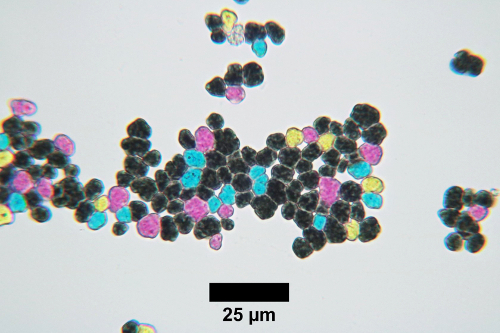What in the (Microscopical) World?
Without the scale bar, you might think this was a photograph of the newest fruity pebble cereal being marketed during Saturday morning cartoons. It isn’t. The presence of the scale bar attests to the fact that it is an altogether different, and perhaps more interesting material.
These particles were collected from the interior of a color laser printer. This dust is composed of discrete toner particles, each having one of four distinct colors: cyan, magenta, yellow, and black. Together, these colors comprise the CMYK color system- the most commonly used system in modern color printing. In various combinations, the three pigments (cyan, magenta, and yellow) can be used to form a wide variety of colored hues on a printed page. All three can be combined to form black, but a separate black toner is used for a variety of practical reasons (e.g., to achieve a deeper, truer black color, to save on ink, to reduce registration issues). More advanced printing systems utilize additional color cartridges to produce a wider variety of hues (i.e., they expand the potential color space).
The ability to recognize toner particles when they are present is only possible if you know what they look like in the first place. As Pasteur famously said, “chance favors the prepared mind.” Higher resolution imaging using low voltage field emission electron microscopy provides a means to obtain information about the size, micromorphology, and surface of discrete particles, while confocal Raman microspectroscopy permits identification of the specific colorants used to produce these colors.
From toner particles to any particle, Microtrace specializes in characterizing and identifying unknown dusts, residues, particles, and materials.
How May We Help You?
Contact usto discuss your project in more detail.








